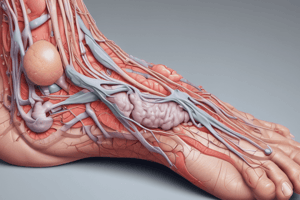Podcast
Questions and Answers
What are the four main appendages of the skin?
What are the four main appendages of the skin?
Sweat glands, sebaceous (oil) glands, hair, and nails
What are sebaceous glands?
What are sebaceous glands?
Oil glands responsible for lubricating skin, preventing brittle hair, and killing bacteria. Activated at puberty.
What is an eccrine gland?
What is an eccrine gland?
Found all over the body, produce sweat and release secretions onto the skin surface via pores.
What is an apocrine gland?
What is an apocrine gland?
What is the composition of sweat?
What is the composition of sweat?
What is the function of sweat?
What is the function of sweat?
What is hair?
What is hair?
What are sudoriferous glands?
What are sudoriferous glands?
What is a hair follicle?
What is a hair follicle?
What is a hair root?
What is a hair root?
What is a hair shaft?
What is a hair shaft?
What is the growth zone (hair bulb matrix)?
What is the growth zone (hair bulb matrix)?
What is the arrector pili muscle?
What is the arrector pili muscle?
What is the central medulla?
What is the central medulla?
What is the cortex?
What is the cortex?
What is the hair cuticle?
What is the hair cuticle?
What are nails?
What are nails?
What is the free edge of a nail?
What is the free edge of a nail?
What is the nail body?
What is the nail body?
What is the nail root?
What is the nail root?
What are skin (nail) folds?
What are skin (nail) folds?
What is the nail cuticle?
What is the nail cuticle?
What is the nail matrix?
What is the nail matrix?
What is a lunula?
What is a lunula?
Flashcards are hidden until you start studying
Study Notes
Skin Appendages Overview
- Skin appendages include sweat glands, sebaceous glands, hair, and nails.
Sebaceous Glands
- Oil-producing glands crucial for skin lubrication and hair health.
- Function to prevent brittleness and inhibit bacterial growth.
- Activation occurs during puberty.
Types of Sweat Glands
- Eccrine Glands:
- Dispersed across the body, responsible for sweat production.
- Secretions exit through skin pores.
- Apocrine Glands:
- Located in the genital area and armpits.
- Release secretions into hair follicles; contents include fatty acids and proteins that produce odor when interacting with bacteria.
Sweat Composition and Function
- Sweat consists of water, salts, vitamin C, metabolic waste, and fatty acids (only from apocrine glands).
- Functions to cool the body, excrete waste products, and its acidity helps control bacterial growth.
Hair Structure and Features
- Hair is a keratin-based structure produced by hair follicles.
- Hair Follicle: Generates new hair.
- Hair Root: Embedded portion within the follicle.
- Hair Shaft: Visible section of hair exterior to the scalp.
- Growth Zone (Hair Bulb Matrix): Located in the follicle, responsible for hair cell production.
- Arrector Pili Muscle: Smooth muscle that raises hair in response to cold or fright, leading to goosebumps.
- Layers of Hair:
- Central Medulla: Inner layer of the hair shaft.
- Cortex: Surrounds the medulla.
- Cuticle: Outer layer of the hair shaft, heavily keratinized.
Nails Structure
- Nails are keratinized modifications of the epidermis.
- Free Edge: The unattached white portion extending from the finger or toe.
- Nail Body: The visible part of the nail that adheres to the skin.
- Nail Root: Embedded in the skin, forming the base of the nail.
- Skin Folds (Nail Folds): Define the borders around each nail.
- Nail Cuticle: The proximal fold that extends onto the nail body.
- Nail Matrix: Area proximal to the cuticle where nail cells proliferate.
- Lunula: The white crescent shape at the base of the nail, visible through the nail body.
Studying That Suits You
Use AI to generate personalized quizzes and flashcards to suit your learning preferences.




